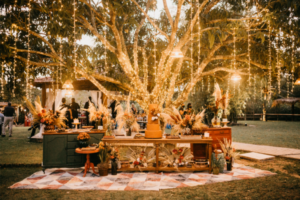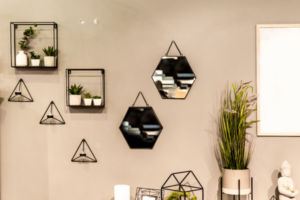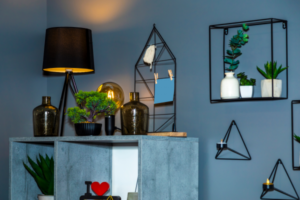Interior design has come a long way from its conventional roots. The evolution of interior design over the years has been marked by innovative ideas, new materials, and a profound shift in the way spaces are perceived and utilized. In this article, we will embark on a journey to explore the world of contemporary interior design, uncovering the latest trends, innovative concepts, and the endless possibilities that designers are exploring to create stunning and functional living spaces.
The Essence of Contemporary Interior Design
Contemporary interior design is more than just a trend; it’s a reflection of our evolving lifestyles, technology, and cultural influences. At its core, contemporary interior design embodies the spirit of the present moment, constantly adapting and pushing boundaries. It celebrates simplicity, functionality, and a harmonious blend of form and function.
Minimalism as a Guiding Principle
One of the defining features of contemporary interior design is minimalism. Minimalist interiors are characterized by clean lines, uncluttered spaces, and a focus on essential elements. The “less is more” mantra is often applied, creating serene environments that allow occupants to focus on what truly matters.
Minimalist interiors are devoid of unnecessary ornamentation and excessive decoration. Instead, they emphasize the use of space, light, and materials to create a sense of tranquility and balance. Furniture and accessories are carefully curated, often with a preference for pieces that are both aesthetically pleasing and functional.
Open Concept Living
Another hallmark of contemporary interior design is the prevalence of open-concept living spaces. Walls are torn down to create fluid, interconnected areas that foster social interaction and maximize natural light. The open-plan layout has become a popular choice for homes, apartments, and even commercial spaces.
Open concept living blurs the lines between different areas, such as the kitchen, dining, and living rooms, creating a sense of spaciousness and unity. This design approach encourages flexibility and adaptability, allowing occupants to customize their living spaces to suit their needs.
Contemporary Design Materials and Finishes
Innovative materials and finishes play a pivotal role in contemporary interior design. Designers are continually exploring new textures, colors, and materials to create distinctive and visually striking spaces. Some of the materials that have gained popularity in recent years include:
Sustainable Materials
Sustainability is a key consideration in contemporary interior design. Designers are increasingly using eco-friendly and renewable materials, such as reclaimed wood, bamboo, and recycled metal, to reduce the environmental footprint of their projects. These materials not only contribute to a greener planet but also add a unique character to interior spaces.
Smart Materials
Advancements in technology have given rise to smart materials that can change properties in response to external factors. For example, thermochromic materials change color with temperature variations, while electrochromic glass can adjust its opacity to control the amount of natural light entering a room. These innovative materials are transforming the way we interact with our surroundings and are being integrated into contemporary interior design concepts.
Natural Textures
The tactile experience is an essential aspect of interior design. Contemporary designers are drawn to natural textures like stone, marble, and raw wood. These materials bring an organic and earthy feel to spaces, creating a sense of warmth and comfort.
High-Gloss Finishes
On the opposite end of the spectrum, high-gloss finishes are gaining popularity for their ability to create sleek and futuristic interiors. Glossy surfaces, often achieved through lacquered furniture and reflective materials, add a touch of luxury and sophistication to contemporary design.
The Role of Technology
Technology has revolutionized contemporary interior design in numerous ways. From smart home systems to virtual reality (VR) and augmented reality (AR) tools, technology is shaping the design process and enhancing the functionality of interior spaces.
Smart Home Integration
The concept of a “smart home” has become increasingly prevalent in contemporary interior design. Home automation systems allow homeowners to control lighting, temperature, security, and entertainment systems through their smartphones or voice commands. These integrated technologies not only enhance convenience but also contribute to energy efficiency.
Virtual Reality (VR) and Augmented Reality (AR)
Designers are using VR and AR technologies to create immersive design experiences. Clients can now take virtual tours of their future spaces, making it easier to visualize the final result. AR apps enable users to overlay virtual furniture and décor in real-time, helping them make informed design choices.
Sustainable Technology
Incorporating sustainable technology is another way contemporary interior designers are making a positive impact on the environment. Energy-efficient lighting, solar panels, and efficient HVAC systems are just a few examples of how technology is used to reduce a space’s carbon footprint.
Contemporary Design Styles
Contemporary interior design is not limited to a single style; it encompasses a wide range of aesthetics, each with its unique characteristics. Some of the popular contemporary design styles include:
Scandinavian
Scandinavian design is known for its simplicity, functionality, and use of natural materials. It often features a neutral color palette, clean lines, and an emphasis on maximizing natural light. Scandinavian interiors create a cozy and inviting atmosphere.
Industrial
Industrial design draws inspiration from warehouses and factories. Exposed brick walls, metal beams, and concrete floors are typical elements. This style embraces the raw and unfinished, resulting in a gritty yet stylish look.
Mid-Century Modern
Mid-century modern design harks back to the mid-20th century and features clean lines, organic shapes, and a blend of traditional and modern materials. Iconic furniture pieces from this era, such as Eames chairs, remain popular in contemporary interiors.
Bohemian
Bohemian design is all about self-expression and an eclectic mix of patterns, textures, and colors. It often incorporates handmade and globally sourced décor, creating a vibrant and free-spirited atmosphere.
Minimalist
As mentioned earlier, minimalism is a significant aspect of contemporary design. Minimalist interiors are characterized by simplicity, monochromatic color schemes, and a focus on functionality.
Biophilic
Biophilic design seeks to connect interior spaces with nature. It incorporates natural materials, greenery, and ample natural light to create environments that promote well-being and a sense of harmony with the natural world.
Designing for Functionality
Contemporary interior design places a strong emphasis on functionality and practicality. Spaces are designed to meet the specific needs of their occupants while maintaining a sense of beauty and aesthetics.
Multi-Functional Furniture
With the increasing trend of smaller living spaces, multi-functional furniture has gained popularity. Sofas that can transform into beds, dining tables with built-in storage, and wall-mounted desks are just a few examples of how contemporary design maximizes space utilization.
Ergonomics
Ergonomics, the study of designing products and spaces to optimize human well-being and performance, plays a crucial role in contemporary interior design. Furniture and fixtures are designed with ergonomics in mind to ensure comfort and efficiency.
Sustainable Practices
Sustainability is not limited to materials; it also extends to the functionality of a space. Contemporary interiors often incorporate energy-efficient lighting, HVAC systems, and water-saving fixtures to reduce resource consumption.
The Influence of Culture and Art
Contemporary interior design is heavily influenced by culture and art. Designers draw inspiration from various cultures and art movements, incorporating them into their projects to create unique and meaningful spaces.
Global Influences
In our interconnected world, designers have access to a wide range of global influences. Moroccan tiles, Japanese shoji screens, and Indian textiles are just a few examples of how international elements can be integrated into contemporary interiors, adding depth and character.
Art as a Focal Point
Art plays a significant role in contemporary interior design. Whether it’s a striking painting, a sculptural installation, or a gallery wall, art can serve as a focal point that anchors the design of a space. Contemporary interiors often feature curated art collections that reflect the tastes and interests of the occupants.
The Future of Contemporary Interior Design
As we look to the future, the world of contemporary interior design is poised for further innovation and evolution. Several emerging trends and concepts are shaping the future of interior design:
Biotechnology Integration
The integration of biotechnology is on the horizon. Living walls, which use plants to purify air and provide a sense of nature indoors, are becoming more prevalent. Additionally, designers are exploring ways to incorporate bioluminescent organisms and materials that respond to biological processes into interiors.
Wellness-Oriented Design
Wellness-oriented design is gaining momentum as people seek spaces that promote physical and mental well-being. This trend includes the use of materials that improve indoor air quality, designs that encourage physical activity, and spaces that foster relaxation and mindfulness.
Virtual Reality-Driven Design
Virtual reality is likely to play an even more significant role in the design process. Designers can create entire virtual environments, allowing clients to fully immerse themselves in their future spaces and make design decisions with greater confidence.
Sustainable and Circular Design
Sustainability will continue to be a driving force in interior design. Designers are increasingly embracing circular design principles, which prioritize the longevity and recyclability of materials and products. Repurposing and upcycling will become even more prevalent.
Conclusion
Contemporary interior design is a dynamic and ever-evolving field that reflects the spirit of our times. It draws inspiration from various sources, incorporates innovative materials and technologies, and prioritizes functionality and sustainability. As we continue to embrace new ideas and push the boundaries of design, the possibilities for creating stunning and functional living spaces are limitless. Whether it’s through minimalist aesthetics, sustainable practices, or the integration of technology, contemporary interior design continues to inspire and transform the way we experience our surroundings.



